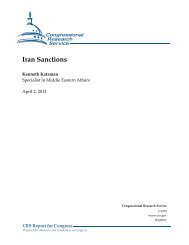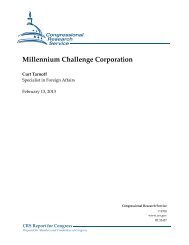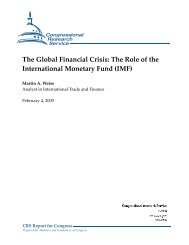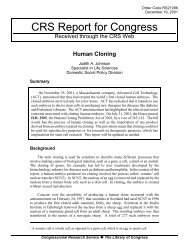North American Oil Sands: History of ... - The Air University
North American Oil Sands: History of ... - The Air University
North American Oil Sands: History of ... - The Air University
Create successful ePaper yourself
Turn your PDF publications into a flip-book with our unique Google optimized e-Paper software.
CRS-2<br />
energy input costs have made some projects less economically viable despite recent<br />
high oil prices. Canada ratified the Kyoto Protocol in 2002, which bound Canada to<br />
reducing its greenhouse gas (GHG) emissions significantly by 2012 but according to<br />
the government <strong>of</strong> Canada they will not meet their Kyoto air emission goals by 2012.<br />
<strong>The</strong> Pembina Institute reports that the oil sands industry accounts for the largest<br />
share <strong>of</strong> GHG emissions growth in Canada. 3<br />
Major U.S. oil companies (Sunoco, Exxon/Mobil, Conoco Phillips, and<br />
Chevron) continue to make significant financial commitments to develop Canada’s<br />
oil sand resources. Taken together, these companies have already committed several<br />
billion dollars for oil sands, with some projects already operating, and others still in<br />
the planning stages. Many <strong>of</strong> these same firms, with the U.S. government, did a<br />
considerable amount <strong>of</strong> exploration and development on “tar sands” in the United<br />
States, conducting several pilot projects. <strong>The</strong>se U.S. pilot projects did not prove to<br />
be commercially viable for oil production and have since been abandoned. Because<br />
<strong>of</strong> the disappointing results in the United States and the expansive reserves in<br />
Canada, the technical expertise and financial resources for oil sands development has<br />
shifted almost exclusively to Canada and are likely to stay in Canada for the<br />
foreseeable future. However, with current oil prices above $60 per barrel and the<br />
possibility <strong>of</strong> sustained high prices, some oil sand experts want to re-evaluate the<br />
commercial prospects <strong>of</strong> U.S. oil sands, particularly in Utah.<br />
This CRS report examines the oil sands resource base in the world, the history<br />
<strong>of</strong> oil sands development in the United States and Canada, oil sand production,<br />
technology, development, and production costs, and the environmental and social<br />
impacts. <strong>The</strong> role <strong>of</strong> government — including direct financial support, and tax and<br />
royalty incentives — is also assessed.<br />
World <strong>Oil</strong> <strong>Sands</strong> Reserves and Resources 4<br />
Over 80% <strong>of</strong> the earth’s technically recoverable natural bitumen (oil sands) lies<br />
in <strong>North</strong> America, according to the U.S. Geological Survey (USGS) (see Appendix<br />
B). Canadian oil sands account for about 14% <strong>of</strong> world oil reserves and about 11%<br />
<strong>of</strong> the world’s technically recoverable oil resources.<br />
3 <strong>Oil</strong> <strong>Sands</strong> Fever, <strong>The</strong> Environmental Implications <strong>of</strong> Canada’s <strong>Oil</strong> Sand Rush, by Dan<br />
Woynillowicz, et. al, <strong>The</strong> Pembina Institute, November 2005.<br />
4 Reserves are defined by the EIA as estimated quantities that geological and engineering<br />
data demonstrate with reasonable certainty to be recoverable in future years from known<br />
reservoirs under existing economic and operating conditions. Resources are defined<br />
typically as undiscovered hydrocarbons estimated on the basis <strong>of</strong> geologic knowledge and<br />
theory to exist outside <strong>of</strong> known accumulations. Technically recoverable resources are those<br />
resources producible with current technology without consideration <strong>of</strong> economic viability.











